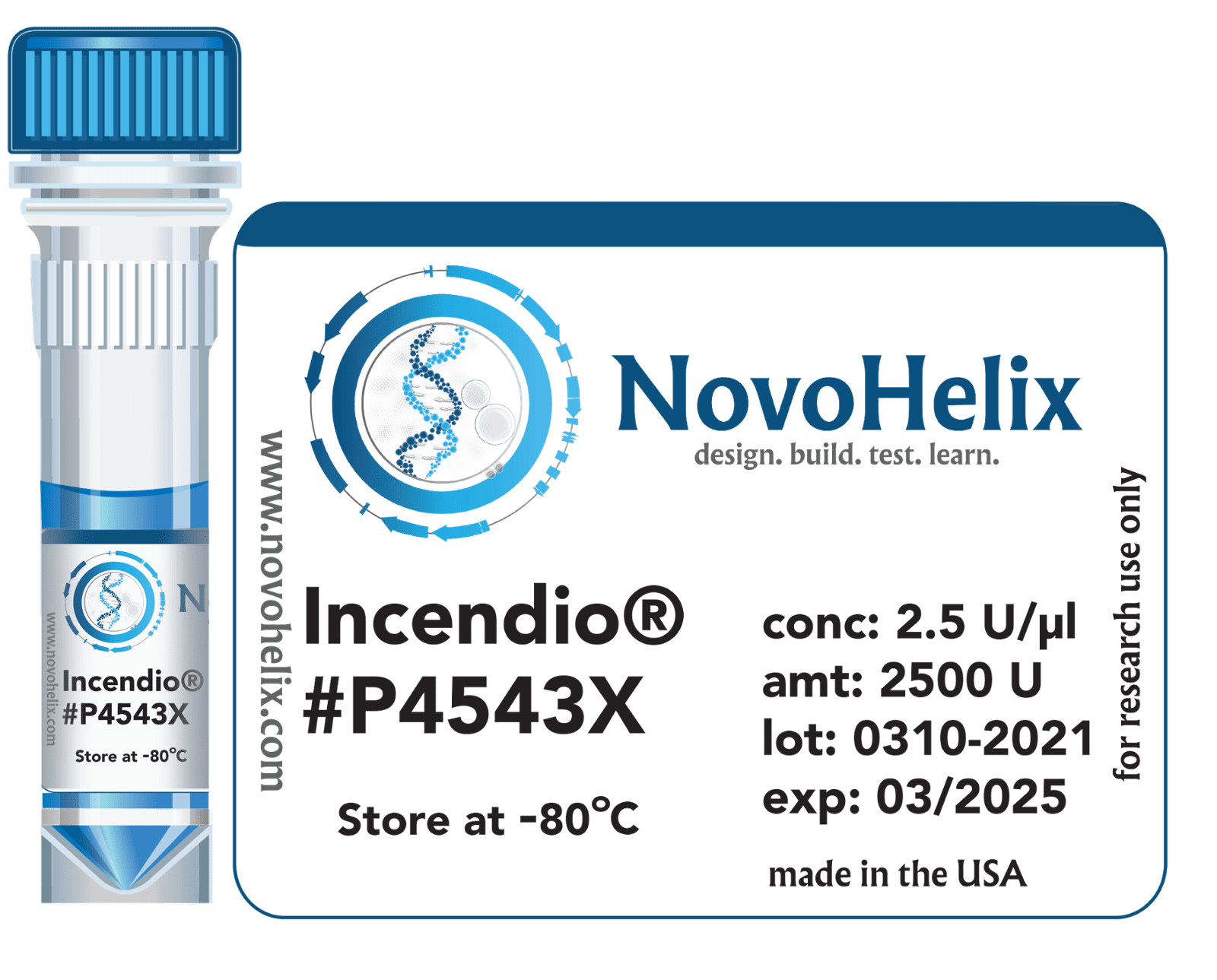Incendio® fast PCR DNA polymerase
Product
Catalog Nr
Size
Concentration
Pricing
Incendio®
P4346B
bulk
Want to try this product? Request a sample of Incendio®
Product Information
FAQs & Troubleshooting
References
Supporting Documents
Product Information
Applications:
- breakneck speed, >8-fold quicker than native Pfu and 4-fold faster than Taq
- Fast PCR ramping and thermocycling to shorten amplification timetables
- extremely processive, increases the yield and specificity of PCR products
- proofreading activity results in 80-fold lower PCR mutation frequency relative to native Taq
- amplicons are blunt PCR products
Source:
Incendio® fast DNA polymerase was originally sourced from a hyperthermophilic archaeon and improved through combinatorial protein engineering efforts such as directed evolution and rational design. The final engineered enzyme was synthesized as a codon-optimized minigene, was expressed heterologously in a chassis such as Escherichia coli or Vibrio natriegens with the assistance of chaperone proteins and was purified by proprietary chromatographic techniques. This product is manufactured in the USA using chemically-defined components and, therefore, does not contain manufacturing components such as serum or animal-derived raw materials. Incendio® is suitable for fast cycling applications and screening of long-range recombinant junctions to validate CRISPR-gene-edited loci.
Molecular Weight:
~90 kDa
Unit Definition:
One unit is defined as the amount of enzyme required to catalyze the incorporation of 10 nmol of dNTPs into acid insoluble material in 30 minutes at 72°C under standard DNA polymerase assay conditions.
Residual Nuclease Activity:
Incendio® is free from detectable RNase A, endonuclease (nicking) and non-specific DNase activities as determined by fluorometric assays using cleavable fluorescent-labeled substrates to be less than the limit of quantitation ≤ 0.3 pg/ml.
Heat Inactivation:
The polymerase is extremely thermostable, and unable to be heat-inactivated. Incendio® fast DNA polymerase half-life is ~12h at 95°C, ~3.5 h at 98°C.
Supplied With:
10x Incendio® Reaction Buffer
200 mM Tris pH 8.820 mM MgSO₄100 mM KCl80 mM (NH₄)₂SO₄0.5% Triton X-1000.1% IGEPAL CA-6301 mg/ml rHSA (recombinant human serum albumin)
Supplied In:
50 mM Tris-HCl (pH 8.0)0.1 mM EDTA1 mM TCEP0.001% Tween 200.001% IGEPAL CA-63050% (v/v) glycerol
Biological Activity:
Incendio® fast DNA polymerase is assayed for its specificity and efficiency in amplifying long fragment targets within the human and mouse genomes. A long-range PCR assay was developed for screening of mouse embryonic stem cell lysates at the CRISPR-edited safe harbor locus Rosa26. Screening across the recombinant junction of the 5’ Rosa26 homology arm is challenging due to high GC-content. Amplification with Incendio® DNA polymerase in a long-range PCR reaction yields a 2,257-bp 5’ Rosa26 amplicon.
Additionally, Incendio® fast DNA polymerase is tested for amplification of the full-length 17-kb human XIST cDNA using an abbreviated PCR extension step. The long XIST amplicon is separated by pulsed-field gel electrophoresis (PFGE) in 1% agarose gel containing a TBE buffer and Sanger sequenced to confirm PCR product identity.
Appearance:
A sterile, aqueous, clear and colorless solution.
Storage & Stability:
The product is shipped at ambient temperature. Upon receipt, store it immediately at -20°C.
Store Incendio® DNA polymerase, 10x PCR Buffer with Mg2+, 5x GC-enhancer, and dNTPs (if supplied) at -20°C. Use proper aseptic technique and work in a PCR workstation to avoid contamination of reagents.
These products may be shipped at room temperature or with blue ice and should be stored immediately upon arrival at -20°C. When stored under the recommended conditions and handled correctly, these products should be stable for at least 1 year from the date of receipt. Approximately 30 minutes before use, thaw the product and its components in an ice bucket and mix thoroughly by gently vortexing at a low speed. After thawing, these products should be kept on ice or a 4˚C cold block before use.
Avoid repeated freeze-thaw cycles by aliquoting to reduce the loss of enzymatic activity. Thawed aliquots are stable for 1-week if stored at 2-8˚ C.
Disclaimer & Precautions:
This product is solely for research and development use only and may be subject to conditional use and licensing restrictions. The product shall not be used as an advanced pharmaceutical intermediate (API) or investigational drug or a biologic. This product is not intended to be used as a therapeutic agent or facilitate clinical diagnosis or be used as an in vitro diagnostic (IVD) product.
The Food and Drug Administration (FDA) and Center for Biologics Evaluation and Research (CBER) define an IVD as: “In vitro diagnostic products are those reagents, instruments, and systems intended for use in the diagnosis of disease or other conditions, including a determination of the state of health, in order to cure, mitigate, treat, or prevent disease or its sequelae. Such products are intended for use in the collection, preparation, and examination of specimens taken from the human body. These products are devices as defined in section 201(h)of the Federal Food, Drug, and Cosmetic Act (the act), and may also be biological products subject to section 351 of the Public Health Service Act. Title 21, Code of Federal Regulations (CFR), section 809.3(a).”
This product may not be used or formulated in any agricultural, pesticidal, veterinary or animal products, food additives or household chemicals or any other unspecified use. Please consult the Safety Data Sheet for information regarding hazards and safe handling practices. NovoHelix distributes products for basic and translational research use only.
Notice to purchaser:
The purchase price of this product includes a limited, non-transferable license under U.S. and foreign patents or applications owned by NovoHelix to use this product. No other license under these patents or applications is conveyed expressly or by implication by purchase of this product.
FAQs & Troubleshooting
References
1: DiDonato M, Krishna SS, Schwarzenbacher R, McMullan D, Jaroszewski L, Miller MD, Abdubek P, Agarwalla S, Ambing E, Axelrod H, Biorac T, Chiu HJ, Deacon AM, Elsliger MA, Feuerhelm J, Godzik A, Grittini C, Grzechnik SK, Hale J, Hampton E, Haugen J, Hornsby M, Klock HE, Knuth MW, Koesema E, Kreusch A, Kuhn P, Lesley SA, Moy K, Nigoghossian E, Okach L, Paulsen J, Quijano K, Reyes R, Rife C, Spraggon G, Stevens RC, van den Bedem H, Velasquez J, White A, Wolf G, Xu Q, Hodgson KO, Wooley J, Wilson IA. Crystal structure of a single-stranded DNA-binding protein (TM0604) from Thermotoga maritima at 2.60 A resolution. Proteins. 2006 Apr 1;63(1):256-60. PubMed PMID: 16435371.
1: Rapley R. Enhancing PCR amplification and sequencing using DNA-binding proteins. Mol Biotechnol. 1994 Dec;2(3):295-8. PubMed PMID: 7866882.
1: Olszewski M, Grot A, Wojciechowski M, Nowak M, Mickiewicz M, Kur J. Characterization of exceptionally thermostable single-stranded DNA-binding proteins from Thermotoga maritima and Thermotoga neapolitana. BMC Microbiol. 2010 Oct 15;10:260. doi: 10.1186/1471-2180-10-260. PubMed PMID: 20950419; PubMed Central PMCID: PMC2964679.
1: Olszewski M, Rebała K, Szczerkowska Z, Kur J. Application of SSB-like protein from Thermus aquaticus in multiplex PCR of human Y-STR markers identification. Mol Cell Probes. 2005 Jun;19(3):203-5. PubMed PMID: 15797821.
1: Wang W, Sun L, Zhang S, Zhang H, Shi J, Xu T, Li K. Analysis and prediction of single-stranded and double-stranded DNA binding proteins based on protein sequences. BMC Bioinformatics. 2017 Jun 12;18(1):300. doi: 10.1186/s12859-017-1715-8. PubMed PMID: 28606086; PubMed Central PMCID: PMC5469069.
1: Ali F, Arif M, Khan ZU, Kabir M, Ahmed S, Yu DJ. SDBP-Pred: Prediction of single-stranded and double-stranded DNA-binding proteins by extending consensus sequence and K-segmentation strategies into PSSM. Anal Biochem. 2019 Nov 3;589:113494. doi: 10.1016/j.ab.2019.113494. [Epub ahead of print] PubMed PMID: 31693872.
1: Nanni L, Brahnam S. Set of approaches based on 3D structure and position specific-scoring matrix for predicting DNA-binding proteins. Bioinformatics. 2019 Jun 1;35(11):1844-1851. doi: 10.1093/bioinformatics/bty912. PubMed PMID: 30395157.
Supporting Documents


